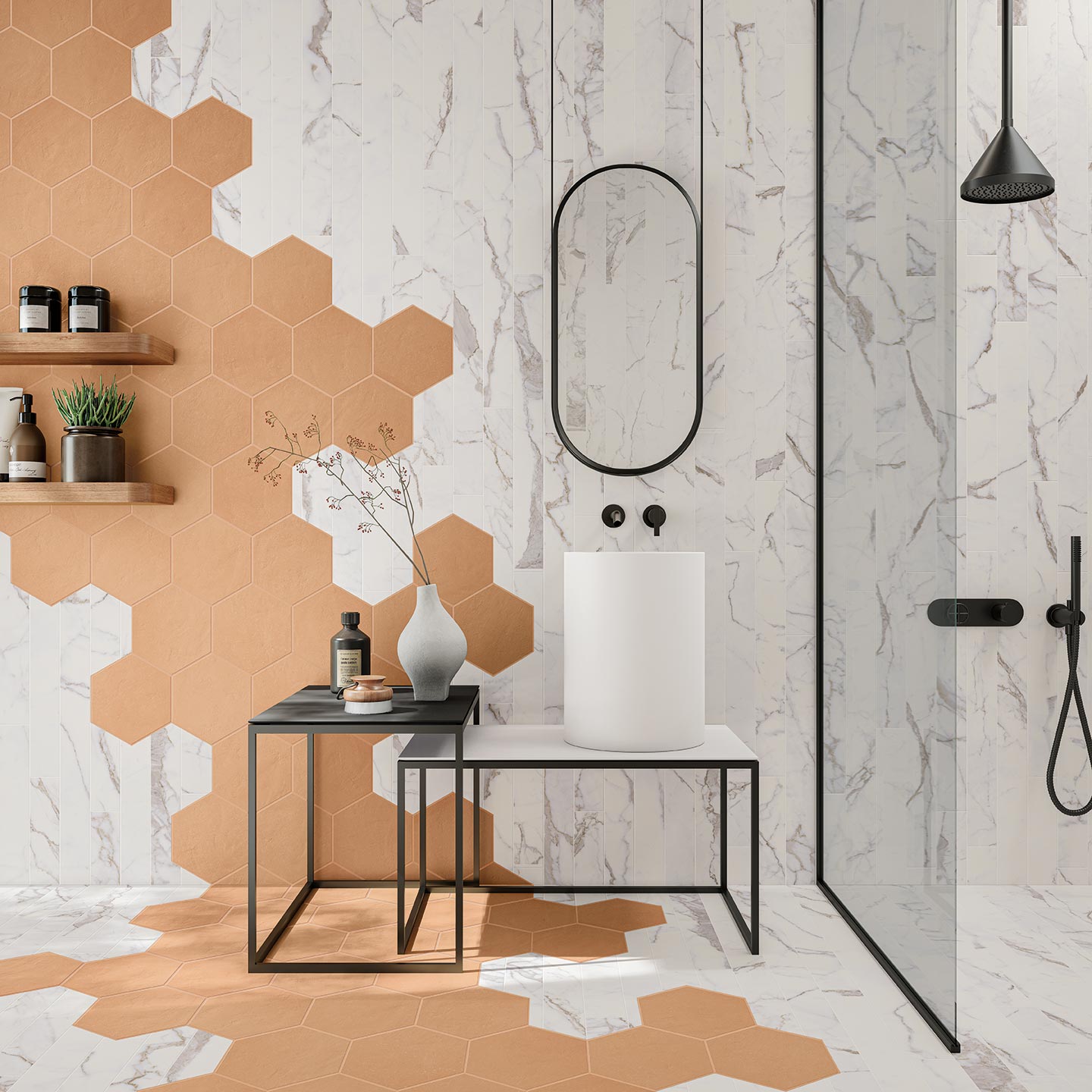
An essential feature of any bathroom, a walk-in shower is more practical than a bath. Simple and accessible, it is more spacious than a shower cubicle. What’s more, it’s highly appreciated for its modern, aesthetic touch that adds charm to your space. However, it must be installed with care and attention to detail. You also need to pay particular attention to the choice of tiles. It must meet certain safety and technical criteria. In the rest of this brief, we’ll look at the key factors that determine the choice of tiles for your bathroom.
The Italian shower: a moment of well-being
The bathroom is undoubtedly a place for relaxation and pampering that deserves special attention. This room of the house needs to be well laid out so that the shower becomes a moment of well-being and relaxation. Aesthetically pleasing as well as practical, the shower is increasingly finding its place at the heart of the bathroom. Easy to access and simple to maintain, it combines aesthetic value, design and functionality. To make the most of this space, the choice of wall and floor coverings is crucial. With a vast range of models available on the market, tiling becomes a decorative element in its own right, creating a place conducive to relaxation.
Criteria for choosing tiles for a walk-in shower
Tiling is ideal for protecting a walk-in shower from damp, and is ideally suited to this room. It withstands water splashing and running. It is also effective against seepage. What’s more, it’s a durable covering because of its resistance. However, there are a few key criteria to bear in mind when choosing tiles for walk-in showers.
Format: from XXL to mosaic
The range of tiles on the market is incredibly varied, offering an abundance of choice. You’ll be faced with many different sizes to choose from. Choose the ones that best suit your preferences and desires. Explore the possibilities to find the ideal size that will transform your space according to your wishes.
XXL tiles
This option is very trendy and always in fashion. These large tiles come in a variety of patterns and colours. XXL tiles are ideal for visually enlarging your bathroom. What’s more, it adds a touch of modernity to your space with its clean lines. This large tile format makes cleaning your Italian shower so much easier. It won’t take long to clean. XXL tiles come in a number of variations: pebbles, waxed concrete, parquet, etc.
Mosaics
Want to create a Scandinavian atmosphere in your walk-in shower? Mosaic tiles are an interesting choice. This option adds extra pizzazz to the space thanks to a beautiful combination of colours. The tesserae of this colourful cladding give the bathroom a dynamic feel and a touch of character. The mosaic can be laid in small vertical or horizontal touches on the surface of your shower. What about colours? Bathroom tiles can come in neutral, bold or warm colours. Whatever the shade, mosaics create a relaxing, soothing atmosphere.
The colour of the tiles
This is a very important selection criterion, because it’s the colour of the tiles that will help you create the ambience you’re looking for: futuristic, contemporary, modern, Provençal… Apart from the aesthetic aspect, the colour of your tiles has a direct impact on how easy it is to maintain your shower area.
The easiest colours to maintain
If you consider cleaning the bathroom to be a chore you’d rather avoid, it’s a good idea to opt for light colours. These make it easier to spot stains and tell whether the tiles are completely clean. Pastel shades and grey are examples of colours that make stains easy to see and clean. Even sanding these tiles doesn’t require hours of work. What’s more, ease of maintenance also depends on the texture of the tiles. Ribbed or marbled surfaces tend to stain more quickly. By choosing smooth, easy-to-clean tiles, you’ll considerably reduce the time and effort needed to maintain your bathroom.
If you’re dreaming of a walk-in shower bathed in light, opt for the total white look. To liven up the space, you can add a beautiful coloured border halfway up the wall.
To create a relaxing atmosphere in your walk-in shower, opt for a neutral colour palette, such as sandy tones. These colours evoke the beach and help to create a soothing atmosphere.
For those who dare…
When it comes to your walk-in shower, you can afford to be a little daring. Why not opt for magnificent shades of blue? From duck blue to Baltic blue to petrol blue, these tones will bring a touch of freshness to your space. To add even more style, you can dare to use cameos. Gradients of colour are very trendy and offer a tie and dye inspiration that will give your bathroom a modern and unique look.
Generally speaking, colour is a matter of taste. So go for shades that evoke well-being and zenitude.
Adhesion and resistance
Choosing the tiles for your walk-in shower isn’t just a matter of taste. This room needs to be comfortable, but above all it needs to be safe. That’s why it’s important to comply with the standards for adhesion and resistance when choosing tiles for your bathroom.
Bond strength
To check the adhesion of your tiles before you buy them, check their R or PC rating. This will give you an idea of how slippery the tiles are when you use them with your feet on. For example, the :
- R9 means normal grip
- R10 means medium grip
- R11 means high grip
The A/B/C or PN standard is also important in bathrooms, as it measures the level of grip of the tiles when you walk on them with bare feet. The grading is as follows:
- A: normal grip
- B: medium grip
- C: high adhesion
If you opt for mosaic as the flooring for your shower, you should be aware that small tiles measuring 5cm x 5cm will provide a more slip-resistant surface. This is because the joints are repeated every 5 cm. The same applies to shower pebbles, which are very slip-resistant. On the other hand, if you choose natural stone, it’s important to make sure it’s not polished, as this would make the surface slippery. Instead, opt for a honed or textured finish, which offers better grip.
As a general rule, we recommend that you opt for tiles with an R10 or R11 standard and a B or C rating. However, if you have any doubts, it’s a good idea to seek professional advice before choosing the tiles for your walk-in shower. This expert will be able to advise you on the best possible alternatives.
Durability
Because tiling is a major investment, it’s important to make sure it lasts. To do this, it’s a good idea to refer to the UPEC standard. It measures tile resistance based on four criteria: Wear, Punching, Water and Chemical agents.
Each of these criteria is rated on a scale of 1 to 4, providing a numerical index that indicates the tile’s level of resistance:
- U “Wear”: this measures the tile’s resistance to abrasion, soiling, piling up, walking on, etc.
- P “Punching”: this index reflects the resistance of tiles to impacts caused by falling objects.
- E “Water”: this indicator gives an idea of the change in appearance of the covering according to the frequency of use of water and the humidity in the shower.
- C “Chemical agents and stains”. This criterion is used to measure the tiles’ ability to resist cleaning agents and various hygiene products.
Materials
There are many types of tiling that can add an aesthetic effect to your walk-in shower and make it a place of well-being. However, the choice of covering will have a significant impact on the overall visual effect of your shower.
Porcelain stoneware tiles
Porcelain stoneware tiles are not just for your terrace or kitchen. It’s also perfect for your bathroom. This type of tile is very hard-wearing. It comes in a range of colours, sizes and dimensions. What’s more, you can lay it in your walk-in shower to perfectly imitate other materials such as natural stone, marble or concrete.
Mosaic tiles
This type of tiling is very popular for the refined look it gives to your shower. With these small tiles, you can create a whole host of patterns and achieve a visual effect reminiscent of spas and hammams. Sometimes, mosaics can be made up of large slabs. Mosaics are made from a wide range of materials, including porcelain stoneware, glass paste and natural stone. You can also personalise your shower by varying the colours. You can opt for a single colour or a combination of colours with a decorated mosaic. The latter is inspired by Morocco or the South of France.
Natural stone tiles
Looking to add a touch of style and modernity to your bathroom? You could opt for natural stone. Very refined and solid, it’s best suited to covering walls because it’s a little slippery. As a result, it is less suitable for floors. Whether it’s marble or granite, these tiles add a touch of class and a natural ambience.
Reconstituted stone tiles
This option is particularly attractive to people who appreciate the look of natural stone but have a tighter budget. Imitation stone tiles offer an affordable alternative that faithfully recreates the look and texture of authentic stone.
Parquet effect tiles
Parquet has become a popular option, even in bathrooms, including walk-in showers. Imitation wood tiles offer an attractive alternative, bringing a warm, natural feel to your relaxation area.




